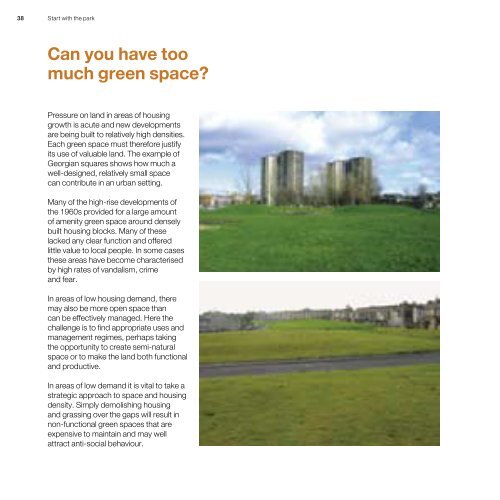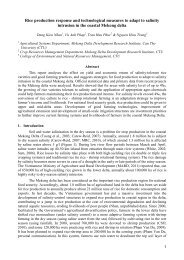start-with-the-park
Create successful ePaper yourself
Turn your PDF publications into a flip-book with our unique Google optimized e-Paper software.
38 Start <strong>with</strong> <strong>the</strong> <strong>park</strong><br />
Can you have too<br />
much green space?<br />
Pressure on land in areas of housing<br />
growth is acute and new developments<br />
are being built to relatively high densities.<br />
Each green space must <strong>the</strong>refore justify<br />
its use of valuable land. The example of<br />
Georgian squares shows how much a<br />
well-designed, relatively small space<br />
can contribute in an urban setting.<br />
Many of <strong>the</strong> high-rise developments of<br />
<strong>the</strong> 1960s provided for a large amount<br />
of amenity green space around densely<br />
built housing blocks. Many of <strong>the</strong>se<br />
lacked any clear function and offered<br />
little value to local people. In some cases<br />
<strong>the</strong>se areas have become characterised<br />
by high rates of vandalism, crime<br />
and fear.<br />
In areas of low housing demand, <strong>the</strong>re<br />
may also be more open space than<br />
can be effectively managed. Here <strong>the</strong><br />
challenge is to find appropriate uses and<br />
management regimes, perhaps taking<br />
<strong>the</strong> opportunity to create semi-natural<br />
space or to make <strong>the</strong> land both functional<br />
and productive.<br />
In areas of low demand it is vital to take a<br />
strategic approach to space and housing<br />
density. Simply demolishing housing<br />
and grassing over <strong>the</strong> gaps will result in<br />
non-functional green spaces that are<br />
expensive to maintain and may well<br />
attract anti-social behaviour.





